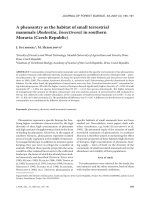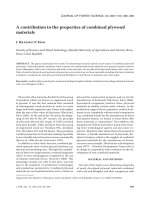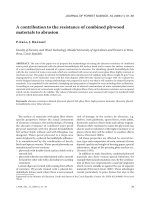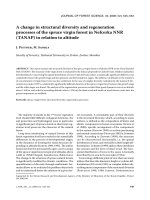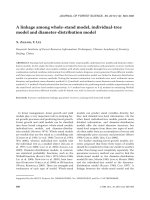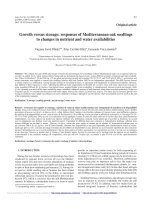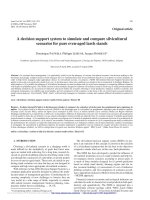Báo cáo lâm nghiệp: " A flow cytometric evaluation of the nuclear DNA content and GC percent in genomes of European oak species" pptx
Bạn đang xem bản rút gọn của tài liệu. Xem và tải ngay bản đầy đủ của tài liệu tại đây (198.39 KB, 3 trang )
Short
note
A
flow
cytometric
evaluation
of
the
nuclear
DNA
content
and
GC
percent
in
genomes
of
European
oak
species
JM
Favre
S
Brown
2
1
Laboratoire
de
biologie
forestière
associé
Inra,
faculté
des
sciences,
BP
239,
54506
Vandœuvre-lès-Nancy
cedex;
2
Cytométrie,
Institut
des
sciences
végétales,
CNRS
UPR
40,
91198
Gif-sur-Yvette,
France
(Received
18
May
1995;
accepted
7
December
1995)
Summary -
The
nuclear
DNA
content
and
GC%
have
been
assessed
for
the
first
time
by
flow
cytometry
in
Quercus petraea
(Matt)
Liebl,
Q pubescens Willd
and
Q robur L.
Values
were,
respecti-
vely,
2C
=
1.87,
1.86
and
1.84
pg
with
41.7,
42.1
and
42.0
GC%.
These
estimates
of
DNA
content
were
greater
than
those
previously
obtained
by
Feulgen
microdensitometry.
This
difference
is
discus-
sed
in
reference
to
effects
of
tanning
in
sample
preparation.
nuclear
DNA
content
/
GC
percent
/
European
oaks
/
flow
cytometry
Résumé -
Évaluation
par
cytométrie
en
flux
du
contenu
en
ADN
nucléaire
et
du
pourcentage
de
GC
chez
des
chênes
européens.
Le
contenu
en
ADN
nucléaire
et
le
pourcentage
de
GC
ont
été
évalués
pour
la
première
fois
par
cytométrie
en
flux
chez
Quercus
petraea
(Matt)
Liebl,
Q
pubescens
Willd
and
Q
robur
L.
Les
valeurs
enregistrées,
respectivement
1,87,
1,86
et
1,84
pg
avec
41,7,
42,1
et
42,0
GC%,
sont
comparables
pour
les
trois
espèces
mais
les
contenus
en
ADN
se
sont
révélés
supérieurs
à
ceux
obtenus
antérieurement
par
microdensitométrie.
Cette
différence
est
discutée
en
relation
avec
les
effets
de
tannage
lors
de
la
préparation
des
échantillons.
contenu
en
ADN
nucléaire
/ pourcentage
de
GC
/
chênes
européens
/
cytométrie
en
flux
INTRODUCTION
Karyotypic
studies
in
genus
Quercus
(Fa-
gaceae)
have
shown
that
the
species
are
diploid,
2n
=
2x
=
24
(Darlington
and
Wylie,
1955;
Moore,
1982)
although
occa-
sional
polyploids
have
been
found
(Bu-
torina,
1993).
Recently,
a
detailed
karyo-
morphological
analysis
in
Q petraea
(Matt)
Liebl,
Q
robur
L and
Q
rubra
L
showed
that
the
different
chromosomes
can
be
identi-
fied
and
paired
on
the
basis
of
C-band
pat-
terns
(Ohri
and
Ahuja,
1990).
These
authors
also
assessed
nuclear
DNA
con-
tent
by
Feulgen
microdensitometry,
obtain-
ing
data
coherent
with
previous
reports
(Bennett
and
Smith,
1991).
In this
note,
we
explore
an
alternative
approach
to
determin-
ing
nuclear
DNA
content
in
Quercus
species
by
using
a
flow
cytometer.
In
conjunction
with
this
procedure, both
intercalating
and
base
specific
dyes
are
used
to
enable
calculation
of
the
AT/GC
base
composition
(=
GC%)
in
a
genome.
The
simple
technique
developed
herein
could
be
extended
to
estimate
the
ploidy
level
of
Quercus
plants
on
the
basis
of
genome
size
relative
to
a
standard
plant
of
known
ploidy.
MATERIALS
AND
METHODS
The
plant
material
was
leaves
of
in
vitro
cloned
plantlets
of
Q
petraea
(Matt)
Liebl,
Q
pubescens
Willd
and
Q
robur
L.
Petunia
hybrida
cv
Px Pc
6
(2C
=
2.85
pg;
41 %
GC)
was
selected
as
an
in-
ternal
standard.
The
Q petraea
and
Q robur
clones
originated
from
donor
trees
in
north-
eastern
France
(Lorraine).
The
Q pubescens
donor
tree
was
from
the
French
southern
Alps
(Provence).
Three
to
four
leaves
of
a
single
in
vitro
grown
2-month-old
plantlet
were
chopped
with
a
razor
blade
together
with
a
leaf
fragment
of
Petunia
in
1
mL
of
Marie’s
nuclear
isolation
buffer
(Marie
and
Brown, 1993)
with
2.2
μL
β-mercaptoethanol
added
fresh
so
that
the
buffer
was
used
within
3
h.
The
crude
suspension
of
nuclei
was
filtered
through
30
μm
nylon.
The
total
nuclear
DNA
was
assessed
after
in-
cubation
with
RNase
(Boehringer),
five
units
per
mL,
and
ethidium
bromide
(Sigma),
30
μg
per
mL,
as
intercalating
dye.
The
proportion
of
AT
was
measured
separately
using
bisbenzi-
mide
Hoechst
33342
(Aldrich),
3
μg
per
mL,
as
base-specific
dye
and
applying
the
fifth
root
re-
lationship
of
Godelle
et
al
(1993):
where
R
Eb
=
Intensity
Quercus
/ Intensity
Petunia
for
ethidium
bromide
and
R
Ho
=
Intensity
Quercus
/ In-
tensity
Petunia
for
Hoechst
33342.
An
EPICS
V
cytometer
(Coulter,
FL,
USA)
was
used
with
an
argon
laser
(Spectra-Physics
2025-
05)
at
488
or
351
+
364
nm,
for
ethidium
bromide
or
Hoechst,
respectively,
taking
emissions
of
>
590
or
408-530
nm.
Each
event
was
analysed
for
pulse
versus
integral
to
avoid
doublets,
as
explained
in
a
general
review
of
the
method
by
Marie
and
Brown
(1993).
Nuclear
DNA
content
values
and
GC%
were
calculated
from
five
to
six
different
samples
of
5
000-6
000
isolated
nuclei
for
each
dye.
Conversion
of
mass
values
into
base-
pair
number
was
done
according
to
the
factor
1
pg
=
965
Mbp
(Arumuganathan
and
Earle,
1991).
RESULTS
AND
DISCUSSION
Results
are
given
in
table
I. They
show
a
rela-
tively
uniform
nuclear
DNA
content
and
base
composition
among
the
three
species.
The
DNA
values
are
generally
12%
greater
than
values
previously
published
for
the
genus
Quercus
that
are
all
about
1.6
pg
per
2C
interphasic
nucleus:
Q petraea
2C
=
1.6
pg
(Band,
1984
in
Bennett
and
Smith,
1991),
1.8
pg
(Greilhuber,
1988)
or
1.58
pg
(Ohri
and
Ahuja,
1990),
Q
robur
2C
= 1.59
pg
(Ohri
and
Ahuja,
1990),
Q rubra
2C
=
1.61
pg
(Ohri
and
Ahuja,
1990).
Olszewska
and
Osiecka
(1984)
gave
a
lower
value
for
Q
sessilis:
2C
=1.0
pg.
This
difference
may
be
due
to
different
microdensitometry
methods
used
by
these
authors.
Plant
extracts
from
Quercus
species
are
prone
to
browning
and
tanning
that
can
substantially
interfere
with
Feul-
gen
microdensitometry,
as
demonstrated
by
Greilhuber
(1988)
for
Pinus.
He
stated
that
"a
significant
part
of
the
reports
on
fluc-
tuating
genomic
DNA
contents
can
be
at-
tributed
to
unrecognized
stoichiometric
er-
rors
induced
by
plant
tannins".
Correspondingly,
microdensitometry
tends
to
underevaluate the
DNA content of
nuclei.
To
evaluate
this
fluctuation,
we
tested
five
isolation
buffers
for
cytometric
assessment
of
Quercus
spp
and
found
that
buffers
with
a
high
chelating
capacity
(Marie’s
buffer
and
that
of
Galbraith
et
al,
1983)
ensured
greater
stability
and
uniformity.
It
is
note-
worthy
that
our
cytometric
data
for
Q pe-
traea
concorded
with
the
results
obtained
by
Greilhuber
(1988),
who
has
paid
particu-
lar
attention
to
overcoming
tanning
during
Feulgen
microdensitometry.
The
basic
genome
size
is
not
expected
to
vary
between
various
tissues
of
a
plant.
Notably,
flow
cytometric
data
from
leaf
tissue
and
root
apices
has
always
been
concordant
in
our
laboratory,
eg,
with
Medi-
cago
spp
(Blondon
et
al,
1994)
and
with
Actinidia
spp
(Blanchet
et
al,
1992).
Of
course,
meristematic
activity
and
endore-
plication
may
increase
nuclear
DNA,
but
this
cytometric
calculation
is
based
on
only
the
first
subpopulation
of
nuclei,
the
2C
peak,
avoiding
the
higher
levels.
Yet
an-
other
source
of
variation
can
be
the
in
vitro
procedure.
However,
the
propagation
pro-
cedure
from
axillary
buds
used
here
has
never
been
shown
as
responsible
for
ka-
ryotypic
variation
and
it
is
recognized
as
highly
reliable
in
terms
of
genetic
fidelity.
Starting
with
clonal
material,
we
found
that
the
in
vitro
procedure
had
not
introduced
variability,
as
evidenced
by
our
tight
stand-
ard
deviations.
Unfortunately,
there
are
no
available
microdensitometry
or
flow
cytometry
data
on
the
DNA
content
in
other
Fagaceae
gen-
era
(Castanea,
Fagus,
Nothofagus,
etc).
Therefore,
a
comparison
of
genome
size
within
Fagaceae
is
presently
not
possible.
The
GC%
values
presented
here
are
the
first
for
the
genus
Quercus
and
the
Faga-
ceae
family.
The
values
are
typical
for
higher
plants.
This
type
of
data
can
be
use-
ful
in
planning
molecular
procedures
for
DNA
polymorphism
analysis
or
the
study
of
genetic
architecture
of
genomes
by
RFLP
and
PFGE
(choice
of
rarely
cleaving
re-
striction
enzymes)
or
RAPD
(choice
of
primers),
and
in
speciation
studies
(Go-
delle et al,
1993).
REFERENCES
Arumuganathan
K,
Earle
ED
(1991)
Nuclear
DNA
content
of
some
important
plant
species.
Plant
Mol
Biol Rep 9, 208-218
Bennett
MD,
Smith
JB
(1991)
Nuclear
DNA
amount
in
angiosperms.
Philos
Trans
R
Soc Lond
(Biol)
334,
309-345
Blanchet
P,
Brown
S,
Hirsch
AM,
Marie
D,
Watanabe
K
(1992)
Determination
des
niveaux
de
ploïdie
dans
le
genre
Actinidia
Lindl
par
cytométrie
en
flux.
Fruits
47, 451-460
Blondon
F,
Marie
D,
Brown
S,
Kondorosi
A
(1994)
Ge-
nome
size
and
base
composition
in
Medicago
sativa
and
M
truncatula
species.
Genome
37,
264-270
Butorina
AK
(1993)
Cytogenetic
study
of
diploid
and
spontaneous
triploid
oaks,
Quercus
robur L.
Ann
Sci
For 50 (suppl 1)
144s-150s
Darlington
CD,
Wylie
AP
(1955)
Chromosome
Atlas
of
Flowering
Plants.
Allen
Galband
Unwin,
London,
UK, 520
p
Galbraith
DW,
Harkins
KR,
Maddox
JM,
Ayres
NM,
Sharma
DP,
Firoozabady
E
(1983)
Rapid
flow
cyto-
metric
analysis
of
the
cell
cycle
in
intact
plant
tis-
sues.
Science 220, 1049-1051
Godelle
B,
Cartier
D,
Marie
D,
Brown
SC,
Siljak-Yakov-
lev
S
(1993)
Heterochromatin
study
demonstrating
the
non-linearity
of
fluorometry
useful
for
calculating
genomic
base
composition.
Cytometry
14, 618-626
Greilhuber
J
(1988)
’Self-tanning’
a
new
and
important
source
of
stoichiometric
error
in
cytophotometric
de-
termination
of
nuclear
DNA
content
in
plants.
Plant
Syst Evol 158,
87-96
Marie
D,
Brown
SC
(1993)
Acytometric
exercise
in
plant
DNA
histograms,
with
2C
values
for
seventy
spe-
cies.
Biol
Cell 78,
41-51
Moore
DM
(1982)
Flora
Europaea
Check-list
and
Chro-
mosome
Index.
Cambridge
University
Press,
Cam-
bridge,
423
p
Ohri
D,
Ahuja
MR
(1990)
Giemsa
C-banded
karyotype
in
Quercus
L
(Oak).
Silvae
Genet
39,
216-219
Olszewska
MJ,
Osiecka
R
(1984)
The
relationship
be-
tween
2C
DNA
content,
systematic
position
and
the
level
of
nuclear
DNA endoreplication
during
differen-
tiation
of
root
parenchyma
in
some
dicotyledonous
shrubs
and
trees.
Comparison
with
herbaceous
spe-
cies.
Biochem
Physiol Pflanzen
179,
641-657
